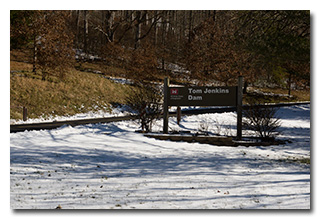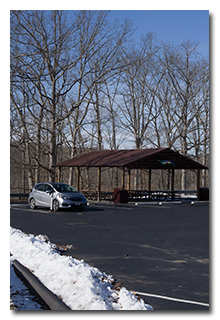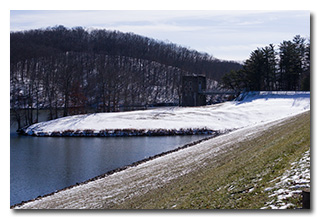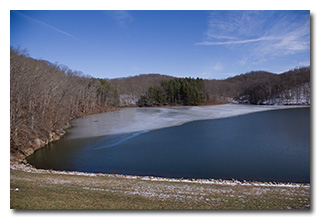
by William Eric McFadden
From the Wayne National Forest website:
-
The Wayne National Forest is a patchwork of public land that covers over a quarter million acres of Appalachian foothills of southeastern Ohio. The Forest is divided into three units managed out of two Ranger District offices located in Nelsonville and Ironton, with a field office in Marietta.
The Forest features over 300 miles of trails for hiking, all-terrain vehicle riding, mountain biking, or horseback riding in season. The trails are open to ATVs, mountain bikes, and horseback riders from mid-April to mid-December each year. Come visit the Wayne and hike or ride our trails!
From the North Country National Scenic Trail website:
-
Come to the North Country. Trek the hills and valleys. Stand on the shores of lakes & streams from glaciers 10,000 years before. Clear-flowing water, red/gold of autumn, a fairyland of snow, open prairies, and distant horizons paint the land. Historic sites along the way tell how America settled and grew as a nation. From North Dakota to New York (and soon Vermont), adventure is never far away.
Pictures
Description
 One member of the Southeast Ohio Radio Adventure Team succeeded in
performing a valid two-fer activation of Wayne National Forest, K-4521, and North Country National
Scenic Trail, K-4239, in Ohio as part of the the Parks on the Air (POTA; link)
program while simultaneously participating in the Arizona ScQRPion's annual Freeze Your B___ Off (FYBO) field event.
On February 6, 2021, Eric McFadden, WD8RIF, visited Wayne National Forest and North Country National Scenic Trail at
Tom Jenkins Dam on a cold but sunny winter morning. Eric participated in FYBO in the Single-Op, Field category.
One member of the Southeast Ohio Radio Adventure Team succeeded in
performing a valid two-fer activation of Wayne National Forest, K-4521, and North Country National
Scenic Trail, K-4239, in Ohio as part of the the Parks on the Air (POTA; link)
program while simultaneously participating in the Arizona ScQRPion's annual Freeze Your B___ Off (FYBO) field event.
On February 6, 2021, Eric McFadden, WD8RIF, visited Wayne National Forest and North Country National Scenic Trail at
Tom Jenkins Dam on a cold but sunny winter morning. Eric participated in FYBO in the Single-Op, Field category.
Eric arrived at the Tom Jenkins Dam at about 1700 UTC and quickly deployed his 28½' wire vertical on his 31' Jackite pole that was held upright by a drive-on base. Having already recorded at the earlier visit to Burr Oak State Park (link) the lowest temperature he was likely to see, Eric chose to operate inside his car and he set up his KX3 on the mobile mount on the car's dashboard. Eric was on the air at 1713 UTC.
 Eric began operations by checking POTA Spots for possible POTA Park-to-Park (P2P) QSOs and at 1715 UTC he made a
P2P QSO on 40m with N5BO who was performing a POTA activation of Tuskegee Airmen National Historic Site (K-0868)
in Alabama.
Eric began operations by checking POTA Spots for possible POTA Park-to-Park (P2P) QSOs and at 1715 UTC he made a
P2P QSO on 40m with N5BO who was performing a POTA activation of Tuskegee Airmen National Historic Site (K-0868)
in Alabama.
Switching to 80m and finding his own frequency there, Eric's first QSO there came at 1720 UTC with his friend K8RAT in central Ohio. This was followed at 1725 UTC with a QSO with W4SK in Tennessee.
Switching to 40m and finding his own frequency there, Eric's first QSO came at 1730 UTC with KS4YX in South Carolina. QSOs came quickly, with Eric's twenty-first QSO in this run coming at 1749 UTC with KG5SSB in Mississippi. This run included a P2P QSO with WI2X who was performing an activation of Fort Wadsworth National Historic Site (K-8087), a P2P QSO with KD4O who was performing an activation of Sesquicentennial State Park (K-2913) in South Carolina, and a P2P QSO with K0BWR who was performing an activation of Little Compton Lake State Conservation Area (K-8253) in Missouri.
Switching to 20m, Eric's first QSO there came at 1758 UTC with K5MUG in Texas. QSOs came steadily, with Eric's fifth QSO on 20m coming at 1809 UTC with KE4Q in Florida.
Checking POTA Spots for more P2P opportunities, Eric made a 40m P2P QSO at 1813 UTC with WW4N who wsa performing an activation of Mt. Roosevelt Wildlife Management Area (K-7605) in Tennessee and he made a 20m P2P QSO at 1820 UTC with NN0G who was performing an activation of Chatfield State Park (K-1212) in Colorado.
In all, Eric made thirty-one QSOs, including six P2P QSOs.
All of Eric's QSOs were CW and were made at the 5-watt level.
Eric also submitted his Wayne National Forest log to the World Wide Flora and Fauna in Amateur Radio (WWFF; link) program.
(return)

